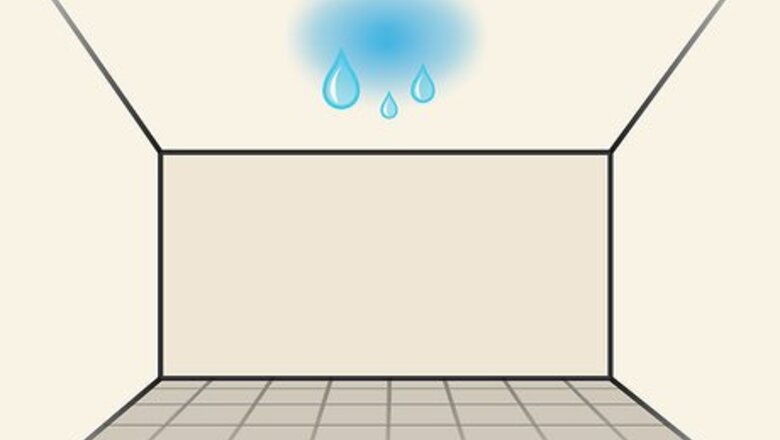
views
Draining the Leak

Look for identifiable signs of moisture. To fix the leak, you'll have to locate the area of your ceiling that is leaking water. If you're unsure of where the water is coming from, look for drywall panels that are sagging or crumbling. You may also notice areas of the ceiling with coffee-colored stains.

Lay down drop cloths or tarps under the leak. Putting down drop cloths or a plastic tarp underneath the bucket will prevent your floors and furniture from getting wet. It will also help collect debris as you replace the water damaged portion of your ceiling.

Put a bucket under the leak. A bucket or container will be able to catch the water that's coming from your ceiling. This will prevent water damage to your floors and will help catch the water from your ceiling once you start draining the leak.

Puncture the ceiling with a screwdriver to drain the leak. Use a screwdriver and push it into the center of the location of the leak. Create the hole away from the ceiling's framing boards. This will cause the water to drain from the ceiling and can help relieve additional water damage. Keep the bucket under the water damaged ceiling so that it can catch the water when you puncture it. If water accumulates over your ceiling the water can weigh down your ceiling and create a large hole or cause it to collapse. If you create a larger hole, you may be able to see where the leak is coming from more easily.

Repair the source of the leak to prevent future damage. Before you replace the portion of your ceiling that's leaking, it's important to fix the source of the leak. Common sources of ceiling leaks include faulty pipes or cracks in your roof. Once you drain the leak, it's important to call a professional roof specialist or handyman who can fix the source of the leak. If the leak is under an area with a kitchen, a bathroom, or some other type of plumbing, this is likely the source of the problem. Other problem areas might include damaged flashing around a roof pipe, a pierced gutter, or a skylight that isn't properly sealed. Another cause of leaks is faulty air conditioning. Your air conditioner's condensate lines could be clogged, leading to overflow that can cause ceiling leaks.
Removing the Damaged Ceiling

Cut a small inspection hole into the drywall. Turn off your electricity before cutting your inspection hole. Before you replace your damaged ceiling, you'll need to know what's on the other side of your ceiling. Cut a small square hole that's deep enough to cut through the drywall, but not deep enough to penetrate anything on the other side. If you cut the hole and see electrical wires, plumbing, gas lines, or HVAC ducts you may need to hire a professional to replace your ceiling.

Draw a box around the water damage. Once you make sure that you won't damage anything behind the ceiling you can start to remove the water damaged ceiling. Use a framing square to draw a box around the portion of your ceiling that has water damage. A framing square will create a square hole that is easier to patch. If the damage is more than 6x6 inches (15.24x15.24 cm) then you should seek professional guidance to fix your leaking ceiling.

Cut around the water damage. Using the lines as a guide, cut into the ceiling with a utility saw and start to cut away the damaged drywall. Once you cut the lines, you can use a small prying instrument to remove the damaged drywall from the ceiling. Try not to remove any more of the ceiling than you need to. It's a lot easier to fix a 1 ft (0.30 m) square patch than an entire ceiling.

Measure the cutout piece of drywall. Use a tape measure or ruler to get the exact dimensions of the drywall that you cut out. Measuring the cut-out piece of drywall will give you the needed dimensions for the drywall replacement.
Replacing the Damaged Ceiling
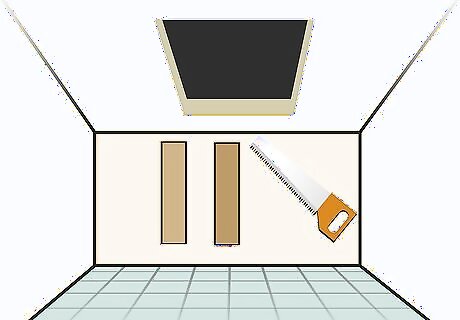
Cut two pieces wood. Use a saw to cut 2 pieces of 9x4x1/2 inch (22.86x10.16x1.27 cm) plywood. These pieces of wood will act as a brace for your drywall. If you cut a hole in your ceiling and you have a metal runner or ceiling beam, then you won't need to create these wooden braces because you can screw directly into the runner or beams instead. Alternatively, you could cut back the drywall to the center of each of the closest framing members, which would allow you to skip this step.

Screw the wooden braces inside of your ceiling hole. Put the wooden braces that you made out of plywood into the hole and lay it flat over your ceiling, so there is a two inch (5.08 cm) overlap over your hole. Then, screw in two screws through your existing ceiling and into the beam. The screws should be on the top and bottom of each piece of wood. Repeat the process on the other side of the hole.

Cut out a piece of drywall that's 2 inches (5.08 cm) wider and longer than the hole. Cutting your replacement drywall two inches longer and wider will leave one inch (2.54 cm) of slack on each side. This is called a hot patch and only recommended to be done on smaller 2-inch x 2-inch (5 cm x 5 cm) patches.

Measure and mark 1 inch (2.54 cm) from the edge of each side of the drywall piece. Turn over the drywall square and use a ruler to measure 1 inch (2.54 cm) in from each edge of the drywall. Then, use a straight edge to draw vertical and horizontal lines so that it looks like a 1 inch wide (2.54 cm) frame around the drywall piece. This slack will let you blend your replacement drywall in with your ceiling so that it lies flush.

Cut through the back layer of the drywall, leaving the front layer of paper. With a utility knife, cut through the back layer of paper and the drywall gypsum until you reach the front layer of the drywall. Use the marks that you made on the back of the drywall as a guide while you cut. Then, use a putty knife to carefully peel back the back layer of paper and drywall gypsum, so that the front side facing paper forms a 1 inch (2.54 cm) frame around your drywall patch. Make sure not to cut too deeply, or you will cut into the front layer of the drywall. You will use the front layer of paper to help blend in your repairs.
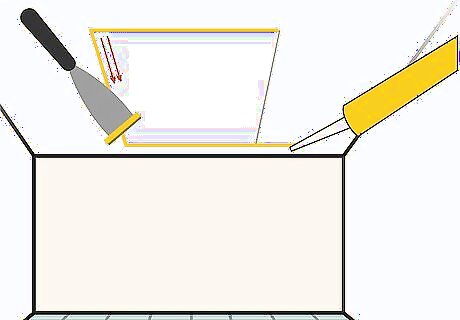
Apply a thin layer of joint compound around the hole. Your drywall patch can be held in place with lightweight or all-purpose drywall compound. You can purchase this compound online or at a hardware store. Apply the joint compound with a trowel to the edges of the hole. Then, with the trowel, carefully spread it around so that it's evenly distributed.

Push your replacement drywall into the hole. On an angle, push your replacement piece of drywall into the hole. Then, adjust the drywall so that it lies flush with your ceiling. The beams that you screwed in earlier will act like a backboard for your new drywall.

Screw the drywall into your wooden braces. Use a power drill to attach the new drywall patch to the wooden braces that you created earlier. Put screws into each corner of the drywall patch to secure it fully. For small patches up to 2-inch x 2-inch (5 cm x 5 cm), you don't have to use screws. Instead, you can use drywall paper to fasten your patch.

Work the compound over the surface of your new drywall. Use the trowel to spread the drywall compound over the surface of your drywall replacement piece. Work the edges of the front facing paper into the ceiling with the compound until there are no visible screws and you can't see the edges of the patch. This will require a few coats of compound.
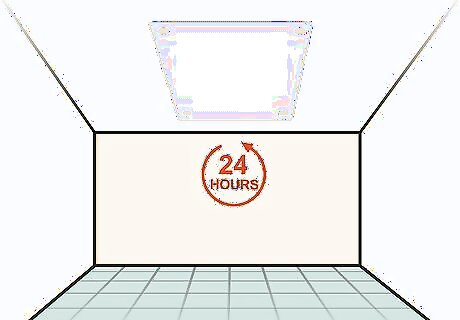
Allow the drywall compound to dry overnight. You can check if it's dry by touching the surface of the drywall compound with your hand. You must let it fully dry before you can sand and paint it.
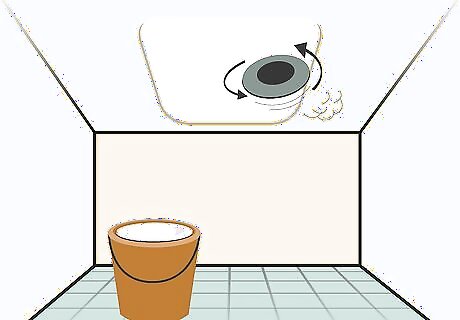
Sand the ceiling and remove excess joint compound. Use a fine-grit sandpaper to sand down the surface of the new drywall. Continue to use a hand sander so that the new drywall lays flush with your ceiling and you can't see the edges of the patch. You can also use a drywall sanding sponge that's made specifically for drywall.

Paint over your new drywall patch. Paint over the new drywall paint using the same paint that was used for your ceiling. If you don't have the original color, you may need to re-paint your entire ceiling so that the new drywall isn't visible. Be sure to prime the area before you paint it.



















Comments
0 comment